Customer Empathy
Customer empathy is essential for lower costs, higher customer satisfaction (Csat), and customer loyalty. Therefore, any call center committed to customer-centricity should ensure that its agents are outstanding at customer empathy. To ensure agents deliver customer empathy consistently, they need to be trained, coached, and monitored through their quality assurance (QA) program and post-call surveys.
It is important to emphasize that customer empathy is not limited to an agent handling a call where the customer is upset or dissatisfied but also applies to all moments of truth (MoT) customers experience interacting with a call center.
Call Center Customer Service MoT Includes:
- Finding the phone number,
- reaching the right agent in a timely manner,
- a warm greeting from the agent,
- understand the reason for the call and identify feelings,
- the agent helping the customer,
- agent caring about customer situations,
- agent resolved the call and,
- after-call work if necessary
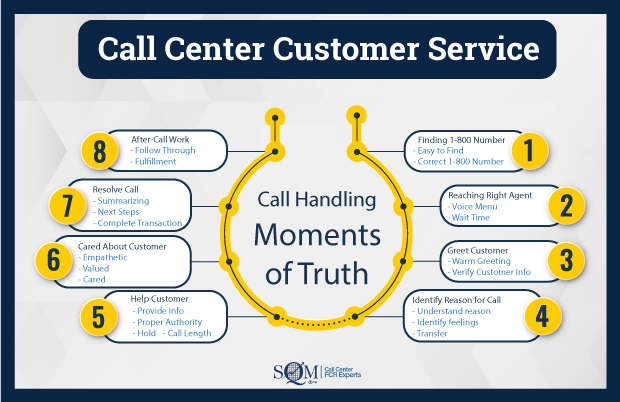
What Is Customer Empathy?
Customer empathy is a call center agent's ability to walk in the customer's shoes by understanding their situation and feelings to help them connect emotionally with the customer. The emotional connection helps guide agents with the necessary actions while using compassion.
Whether a call center customer experience (CX) is great, average, or poor, customer empathy builds an emotional connection and trust between customers and the company. Furthermore, customer empathy can help an agent handle an angry or dissatisfied customer. Building customer empathy throughout the call center can lead to better customer service.
Historically, customer empathy was considered a trait that an agent was born with and could not be taught. However, current thinking is that customer empathy is innate, but an agent can learn to deliver customer empathy by being trained, coached, and monitored through QA and post-call surveys.
From a call center perspective, customer empathy goes beyond the agent's ability to walk in the customer's shoes by understanding their situation and feelings. Customer empathy should be designed in all MoT to ensure call center customer service is great.
Why Is Customer Empathy Important?
Most customers using a call center expect the agent to be able to resolve their inquiry or problem on the first call and provide compassionate customer service. When you consider that most companies compete on customer service delivery, the agent's ability to provide customer empathy can be a big CX differentiator.
The agent's ability to deliver customer empathy can determine if customers will continue to do business with the company. For example, 95% of customers will continue to do business with a company because they have experienced great CX interacting with an agent. Conversely, 88% of customers have stopped doing business with a company because of poor call center customer service. In many cases, the difference between a customer staying or leaving is the agent's ability to be compassionate.
The benefits of empathy can be huge for your customers. For example, when an agent provides customer empathy for handling an inquiry or problem, the interaction can be viewed as a positive, memorable CX. Customer empathy reflects positively on the call center when customers feel:
- They are heard, understood, and valued
- Their issues and concerns are being taken seriously
- The agent is doing everything possible to help them
- The customer experienced first call resolution
How to Show Customer Empathy?
At SQM Group, we have been collecting agent customer service success stories with leading North American call centers for over 15 years. The common theme of these stories is that the agent showed customer empathy. For agents to show customer empathy comes down to the daily actions a call center takes to ensure customers feel heard, understood, and valued. Also, customers feel their issues and concerns are taken seriously, and the agents do everything possible to help them. Here are seven tips for agents to show customer empathy:
- Five Customer Empathy Statements for Achieving Great Csat
- Provide First Call Resolution
- Act on Customer Feedback
- Make it Easy to Resolve an Inquiry or problem
- Build Customer Rapport
- Monitor and Coach Agents for Empathy
- Provide Agents with Customer Empathy Training
1. Five Customer Empathy Statements for Achieving Great Csat.
An agent using customer empathy statements is a way to convey to a customer they understand their situation and feelings and to help them connect emotionally with the customer. Furthermore, agents using empathy statements can demonstrate the desire to solve the customer's problem, answer questions, and deliver a great CX.
Empathy statements are short phrases that help agents connect emotionally with customers. So, here are some empathy statements that an agent can use to help them deliver great customer service:
1. I'm sorry that you experienced this issue.

An agent saying sorry is not the same as admitting your company did something wrong. Saying sorry when a customer is upset is an effective way for an agent to make the customer feel understood and heard. However, agents should avoid coming off to customers using a canned script. Instead, agents need to mean it when they say they are sorry.
2. This has happened to me too.

Customer empathy is an agent's ability to walk in the customer's shoes. For example, an agent telling a customer this has happened to them is telling them that they have walked in their shoes and, as a result, can make an emotional connection to their situation. Furthermore, this approach validates the customer's problems or concerns by confirming that other people have experienced similar concerns, demonstrating that the agent understands their situation.
3. If this happened to me, I would feel the same way as you do.

If a customer had to phone a call center two or more times to resolve the same issue or problem, a customer could feel very frustrated or upset. An agent confirming that they would feel the same way as the customer can create a basis for trust. In addition, not only does it show customer empathy for their situation, but it also makes the customer feel understood and heard.
4. You are absolutely right.

Validating customers' feelings about their situation can be as simple as confirming they are right about an issue or problem. Telling a customer they are absolutely right demonstrates respect and empathy for the customer's viewpoint and situation. A customer might be right about the entire issue or problem or partly right. If the customer is partially right, an agent should look for areas of the situation they can express where the customer is right. Telling a customer they are right about a problem makes them feel heard and that the agent is an advocate for them and will do everything possible to help them.
5. I want to confirm that I understand what you told me. I'm hearing that.

An agent can not show empathy if they do not understand the customer's issue or problem. An agent expressing the desire to deeply listen to the customer's issue or problem by restating what they heard and allowing them to correct them if they are wrong enhances the customer and agent connection and provides great customer service. Also, using "I" in the empathy statement demonstrates an agent's willingness to go the extra mile to understand the problem and help solve the customer's issue.
2. Provide First Call Resolution
When a customer has made repeated calls to resolve the same inquiry or problem, it is the number one driver of customer dissatisfaction. Customers want to experience First Call Resolution. In fact, for every 1% improvement in FCR, there is a 1% improvement in customer satisfaction. It's not empathic to have customers make repeat calls to resolve their inquiries or problems, especially when you consider that 29% of customers have to call back the call center to resolve their inquiries or problem.
Customer service scripts are written words used by call center agents to resolve customer interactions and provide customer empathy. A customer service script is used for phone, email, and chat interactions. Not only do customer service scripts provide your agents with real-time support if they need it, but they are also excellent tools for training new agents and coaching existing agents.
Based on SQM Group conducting over 5 million surveys with customers who used an inbound call center and our customer sentiment analysis, we have determined the top 25 call handling words and phrases that agents need to use for delivering great Csat and FCR.
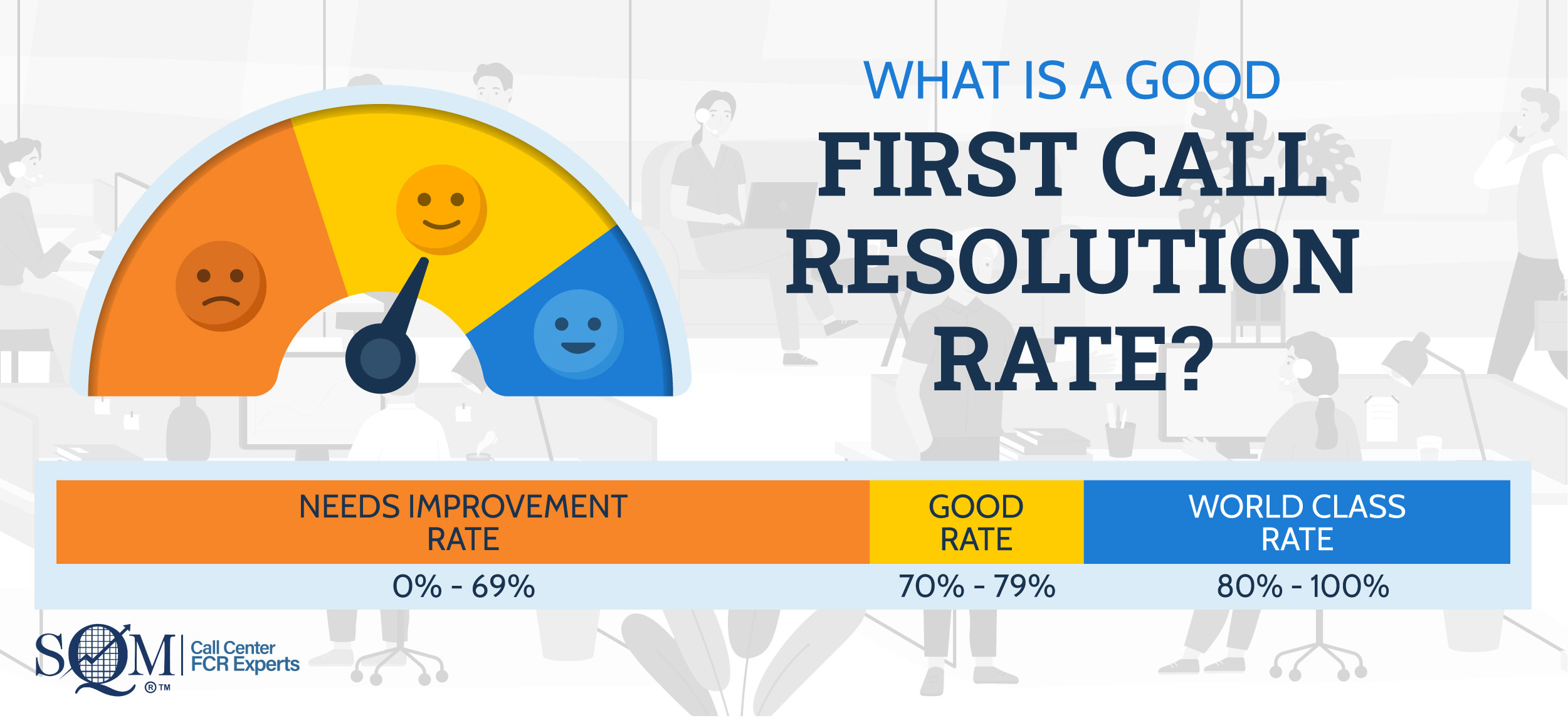
3. Act On Customer Feedback
The best way to understand your customer's experiences is to ask them and, most importantly, to act on customer feedback. According to a Gartner statistic: 95% of companies collect customer feedback. However, only 10% of companies act on customer survey feedback to improve customer experience. Therefore, this represents an excellent opportunity to use customer feedback to improve customer service more effectively.
Customer feedback is important because it is a pillar for delivering great customer satisfaction. Without an effective customer feedback program, it is unlikely for your call center to provide great customer service and make a strong agent and customer emotional connection to help your company retain customers.
Call center customer feedback often tells you what you are good at delivering and what needs improvement. Sometimes, it requires multiple customer feedback methods to understand the opportunities to improve customer experience using a call center and related touchpoints so you can translate the information into meaningful action to improve First Call Resolution and Csat.
A customer feedback loop is a best practice for acting on customer insights to continuously improve the call resolution of customer interactions on the first call and deliver great Csat. The customer feedback loop consists of four steps – Identify, Develop, Check, and Act (IDCA). The customer feedback loop journey is circular, representing a continuous improvement process for improving the customer journey using a call center. The customer feedback loop can be used at the call center or the agent level.
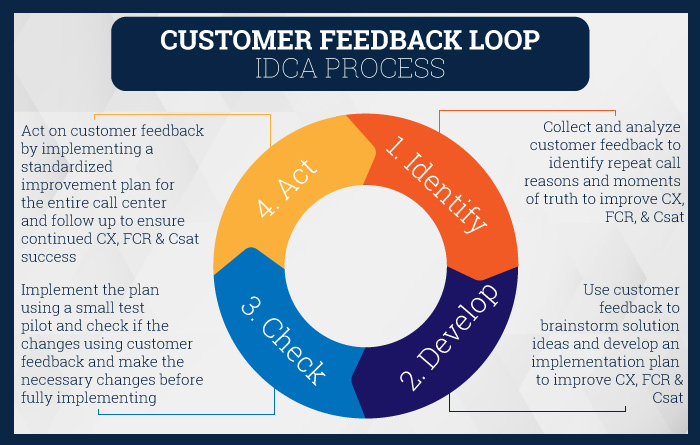
4. Make It Easy to Resolve an Inquiry Or Problem
For many customers using a call center to resolve an inquiry or problem, the ease of doing business can be anything but easy. The below figure shows the average call center's call handling practices from a customer point of view.
SQM's research shows that 19% of all calls are transferred to another agent, the call needs assistance from another agent 20% of the time, and customers are put on hold 46% of the time. In addition, the average handle time (AHT) call length (talk and wrap up) is approximately seven minutes, and 9% of the calls are pending, which means a fulfillment employee needs to provide additional information to complete the interaction.
The call handling data shows that the high percentages suggest the ease of resolving a call reason for a customer using a call center is low. In fact, SQM's research shows that only 5% of call centers achieve a world-class Csat (top box survey response) standard of 85% or higher, and the percentages for the world-class Csat call handling percentages are substantially lower.
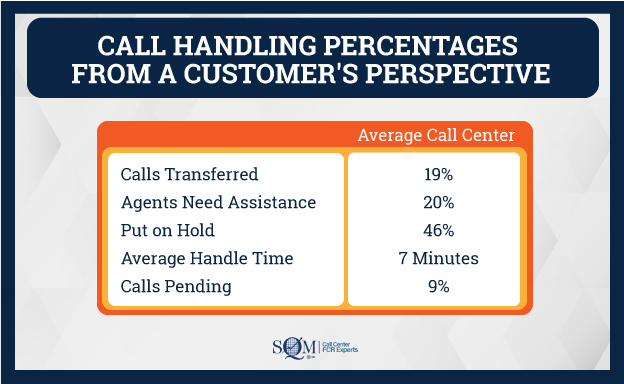
Furthermore, SQM's CX research shows when customers use a call center touchpoint, 93% of customers expect their call to be resolved on the first call, and if they need to use another touchpoint, they expect it to be a seamless experience. In most cases, when a customer uses multiple touchpoints to resolve the same inquiry or problem, it's the call center, chat, email, and website touchpoints.
Also, our research data reveals that when customers use only one touchpoint (e.g., call center, website, IVR, chat, or email) to resolve their inquiry or problem, Csat's top box response is an average of 73%. However, Csat drops 19% for each additional touchpoint used to resolve the same inquiry or problem.
The main reason Csat is so much higher when there is only one touchpoint used is that customer effort was low for resolving their inquiry or problem compared to the customer effort required when using two or more touchpoints.
The figure below shows the main failure reasons when customers use multiple touchpoints to resolve the same inquiry or problem. For example, the number one failure reason was that the customer felt the inquiry or problem was simple enough that the first touchpoint they chose should have resolved their interaction.
Furthermore, when the customer uses the call center after using another touchpoint, the customer expects the agent to access all the information they inputted in the previous touchpoint (e.g., website, chat, email, IVR), so they do not have to start the interaction from the beginning. Therefore, the second biggest failure was information unavailable from another touchpoint. Consequently, the customer needed to repeat themselves to resolve their inquiry or problem, which created high customer dissatisfaction.
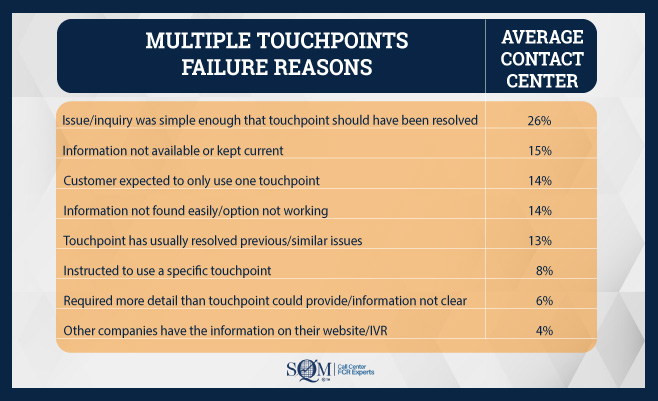
5. Build Customer Rapport
Customer rapport is about establishing and maintaining a positive customer journey to resolve inquiries or problems. Building customer rapport is one of an agent's most essential skills to deliver great customer service. When an agent builds a good rapport, the CX becomes easier for them to handle the call and can help create high Csat and FCR. Furthermore, when an agent builds customer rapport, it can go a long way toward creating a common bond and gaining customer trust.
SQM Group's customer service research shows that building customer rapport is the second biggest driver for achieving high call center Csat. Only an agent resolving a call is a more significant driver for providing high Csat. However, in many cases, agents are not allowed or fail to recognize that their customer interfacing job provides them with an opportunity to help customers by building rapport with them and engaging customers with interesting conversations to help them resolve their interaction.
Therefore, it is vital that agents not only understand the importance of building customer rapport but can demonstrate it in every interaction. This can be challenging for agents, especially when considering the agent and customer conversations happening over the phone versus face-to-face and AHT requirements. In addition, agents can not see the customer's facial and body language, which can hinder building customer rapport.
Here are five tips for building customer rapport:
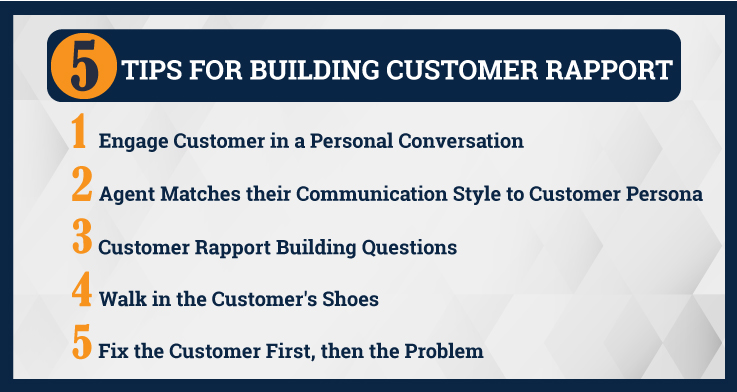
6. Monitor and Coach Agents for Empathy
Monitoring and coaching agents to achieve customer empathy is easier said than done. Sometimes it's hard to understand a customer's inquiry or problem and identify their emotion; other times, determining how to respond can be difficult. So, here are three steps to monitor and coach agents for customer empathy.
1. Understand customer problems.
For an agent to show genuine customer empathy, they need to understand the inquiry or problem. Do not assume you understand the customer's problem. A best practice is for an agent to reinstate the main message the customer mentioned and ask them if they are correct. When an agent demonstrates the desire to understand customers, it makes them feel understood and heard.
2. Identify customer emotions.
Identifying customer emotions using a call center can be challenging because there is no body language. However, an agent can use tonal cues to help them identify the customer's emotion. Furthermore, speech analytics and customer survey data are also helpful for conducting sentiment analysis to identify customer emotion insights to coach agents.
3. Use empathy statements.
After an agent understands the customer's problem and identifies the emotions, they are ready to use the appropriate empathy statements. The use of an empathy statement is a way to convey to a customer they understand their problem and feelings and to help them connect emotionally with the customer. Agents need to be monitored and coached on using the right empathy statement for the customer's problem and emotions on the call.
Agent word choices matter, especially when an agent is talking to an upset or dissatisfied customer. Agents need to know the right words and phrases for delivering great Csat. Below is an example of customer empathy words and phrases that let customers know you understand them, hear them, and that their issue will be resolved.
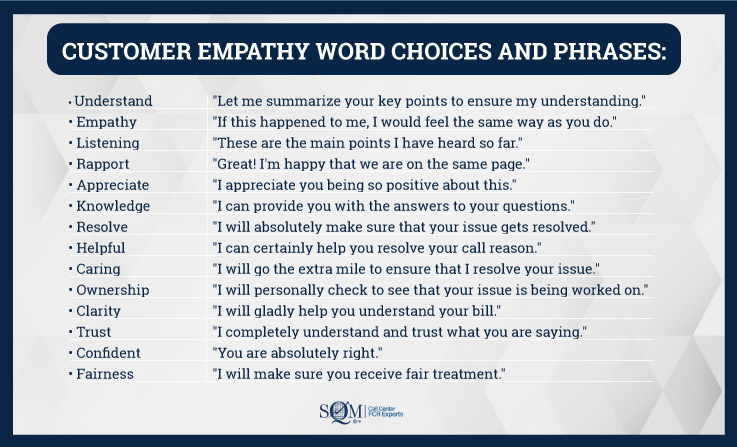
7. Provide Agents With Customer Empathy Training
Training agents on customer empathy skills for most call centers are always a good practice. However, agents need to know how to utilize the new customer empathy skills they learned effectively. For example, active listening skills to demonstrate customer empathy entails five steps:
- Ask the customer how you can help them.
- Listen for key points and feelings.
- Take notes on what you heard.
- Use words to acknowledge listening (yes, I see, I understand, and uh-huh).
- Confirm understanding by restating key points and asking the customer if you are correct.
In addition, customer empathy training for agents should include understanding and empathic word choices and phrases to use in customer interactions.
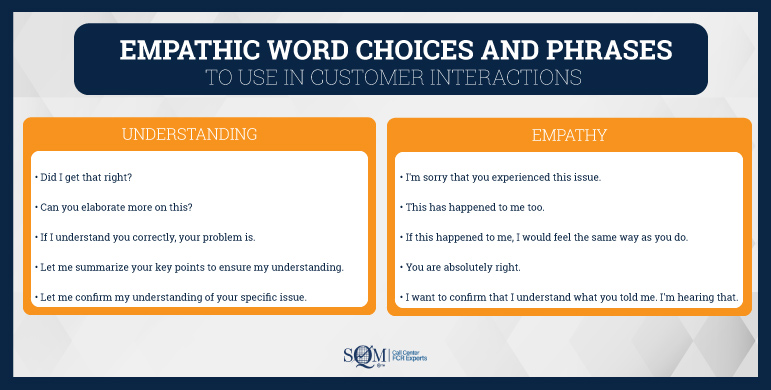
Quick Related Links
First Call Resolution Comprehensive Guide Customer Satisfaction Comprehensive Guide Customer Rapport Customer Service Scripts Good to Great Customer Service
